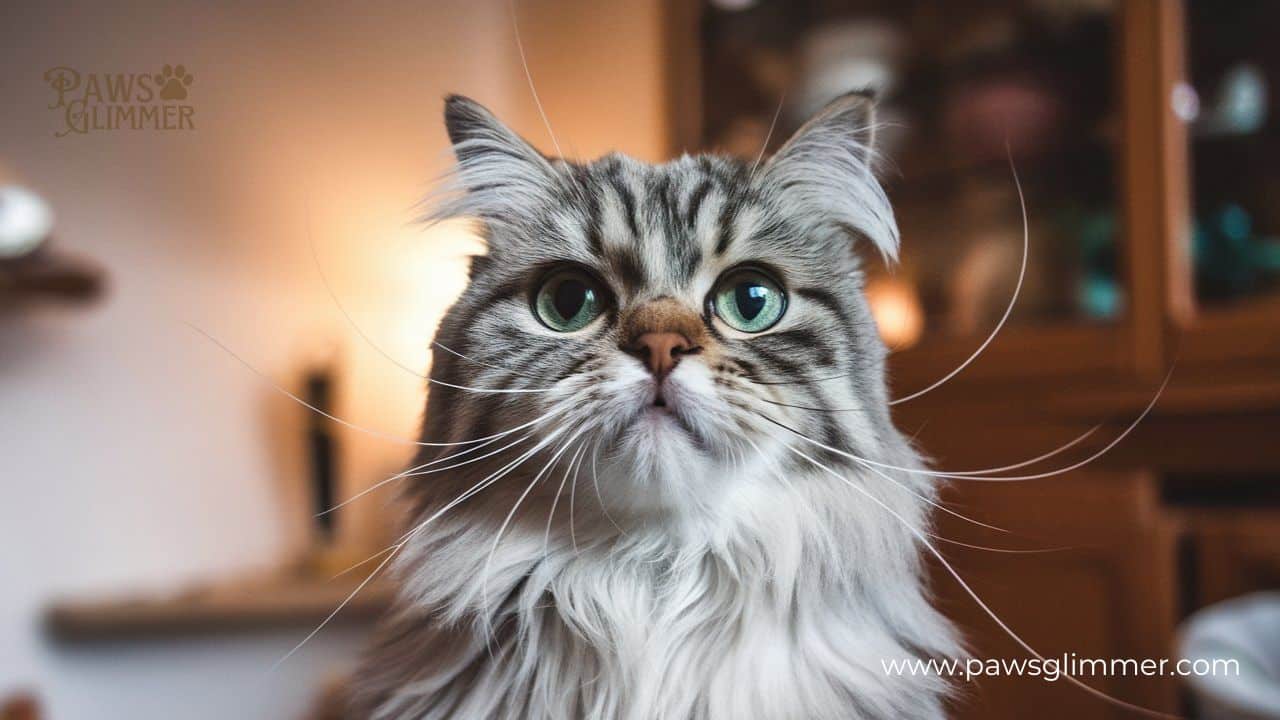Cats never cease to amaze us with their quirks and mysteries. One day, you might notice something peculiar about your feline friend – a single black whisker standing out among the rest. Why does my cat have one black whisker? This unexpected discovery can leave you wondering: What does it mean? Is it normal? Should I be concerned? Let’s dive into the fascinating world of cat whiskers and unravel the mystery behind this intriguing phenomenon.
The Science Behind Cat Whiskers
Before we explore the reasons behind a black whisker, let’s understand what whiskers are and why they’re so important to our feline companions.
What Are Whiskers Made Of?
Cat whiskers, also known as vibrissae, are specialized sensory organs. Unlike regular hair, whiskers are:
- Thicker and more rigid
- Deeply rooted in the cat’s skin
- Connected to the nervous and muscular systems
- Filled with blood vessels and nerves
These unique properties make whiskers essential tools for a cat’s daily life.
Check out Why dogs cry in their sleep.
The Role of Whiskers in a Cat’s Life
Whiskers aren’t just for show – they’re crucial for cat behavior and survival. Here’s how cats use their whiskers:
- Spatial awareness: Whiskers help cats judge distances and navigate tight spaces.
- Balance: They aid in maintaining equilibrium, especially when jumping or climbing.
- Mood indication: The position of whiskers can signal a cat’s emotional state.
- Hunting: Whiskers detect air currents, helping cats locate prey.
- Protection: They serve as an early warning system for potential threats.
How Whiskers Grow and Shed
Like other hair, whiskers go through a natural growth cycle. They typically:
- Grow for about 10-12 weeks
- Remain in place for several months
- Eventually fall out and are replaced by new whiskers
This cycle ensures that cats always have functioning whiskers for their sensory needs.

The Phenomenon of the Single Black Whisker
Now that we understand the basics of whiskers, let’s address the main question: Why might a cat have one black whisker?
Common Occurrence or Rare Oddity?
While not extremely common, a single black whisker isn’t necessarily cause for alarm. It’s a phenomenon that many cat owners have observed and reported. The occurrence can vary based on factors like:
- The cat’s age
- Breed
- Overall health
- Environmental conditions
Genetic Factors at Play
One of the primary reasons for a black whisker is genetic factors. Just as humans can have a single gray hair appear earlier in life, cats can experience localized changes in pigmentation due to their genetic makeup.
Some breeds are more prone to whisker color variations, including:
- Siamese
- Maine Coon
- Russian Blue
Understanding your pets behavior
Age-Related Changes in Whisker Color
As cats age, they may experience changes in their fur and whisker color. This is part of the natural aging process and can result in:
- Graying or whitening of fur
- Darkening of some hairs, including whiskers
- Overall color changes in coat and facial features
Potential Causes of a Black Whisker
While genetics and aging are common factors, there are other potential reasons why your cat might develop a black whisker.
Melanin Production and Distribution
Melanin is the pigment responsible for hair color in both humans and animals. Changes in melanin production can lead to:
- Localized darkening of hair follicles
- Uneven distribution of pigment
- Sudden appearance of darker hairs or whiskers

Stress or Environmental Factors
Believe it or not, stress and environmental exposure can affect your cat’s whisker color. Factors that might contribute include:
- Changes in living environment
- Introduction of new pets
- Alterations in routine
- Exposure to certain chemicals or pollutants
Dietary Influences on Whisker Color
What your cat eats can impact their overall health, including the color of their fur and whiskers. Nutritional factors that may play a role include:
- Protein intake
- Vitamin and mineral balance
- Presence of antioxidants in the diet
Medical Conditions That Might Affect Whisker Pigmentation
In some cases, a change in whisker color could be related to underlying health conditions. While rare, conditions that might affect pigmentation include:
- Hormonal imbalances
- Autoimmune disorders
- Certain types of cancer
It’s important to note that a single black whisker alone is rarely a sign of serious illness, but it’s always best to consult with a veterinarian if you have concerns.
Knowing the law about dog barking
What Does a Black Whisker Mean for Your Cat?
Now that we’ve explored the potential causes, let’s address what a black whisker might signify for your feline friend.
Debunking Myths and Misconceptions
First, let’s clear up some common misconceptions:
| Myth | Fact |
|---|---|
| A black whisker means bad luck | There’s no scientific evidence to support this superstition |
| It indicates a serious health problem | In most cases, a single black whisker is a harmless occurrence |
| The cat’s personality will change | Whisker color doesn’t affect a cat’s behavior or temperament |
| It will spread to all whiskers | While possible, it’s not guaranteed that other whiskers will turn black |
Cultural Perspectives on Black Whiskers
Interestingly, different cultures have various beliefs about black whiskers on cats:
- In some Asian cultures, black whiskers are considered a sign of good fortune
- Some European folklore associates black whiskers with magical abilities
- In certain Native American traditions, they’re seen as a mark of wisdom

Impact on Your Cat’s Sensory Abilities
The good news is that a change in whisker color doesn’t affect its functionality. Your cat’s whisker function remains intact, regardless of its color. The sensory capabilities, including:
- Spatial awareness
- Balance
- Tactile sensation
All continue to work as they should, ensuring your cat can navigate its environment effectively.
When to Be Concerned About Whisker Changes
While a single black whisker is usually not a cause for alarm, there are situations where whisker changes might warrant closer attention.
Explore how long can Calico Cat live?
Normal vs. Abnormal Whisker Color Changes
Normal changes include:
- Gradual color shifts as the cat ages
- Occasional appearance of differently colored whiskers
- Slight variations in whisker thickness or texture
Abnormal changes to watch for:
- Sudden loss of multiple whiskers
- Brittle or breaking whiskers
- Swelling or redness around whisker follicles
- Dramatic and rapid color changes across many whiskers
Signs That Warrant a Vet Visit
Consider scheduling a veterinary consultation if you notice:
- Multiple whiskers changing color rapidly
- Changes accompanied by skin irritation or lesions
- Loss of whiskers along with other symptoms like lethargy or appetite changes
- Any drastic alterations in your cat’s facial appearance
Diagnosing Underlying Health Issues
If your veterinarian suspects an underlying health condition, they may recommend:
- Blood tests to check for hormonal imbalances
- Skin biopsies if there are concerns about dermatological issues
- Imaging studies to rule out any structural abnormalities
Remember, early detection is key in managing any potential health problems.

Caring for Your Cat’s Whiskers
Proper care of your cat’s whiskers is essential for their overall well-being. Here are some tips to ensure your cat’s facial sensors stay in top condition.
Proper Grooming Techniques
When grooming your cat:
- Never trim or pluck whiskers
- Be gentle when cleaning around the face
- Use cat-specific grooming tools to avoid damaging delicate facial hair
- Monitor for any changes in whisker appearance or texture
Dietary Considerations for Healthy Whiskers
A balanced diet promotes healthy hair growth, including whiskers. Ensure your cat’s diet includes:
- High-quality protein sources
- Essential fatty acids for skin and coat health
- Vitamins and minerals that support hair growth
Consult with your vet about the best diet for your cat’s specific needs.

Creating a Whisker-Friendly Environment
To protect your cat’s sensitive whiskers:
- Use wide, shallow food and water bowls to prevent whisker fatigue
- Provide plenty of space for your cat to move without brushing their whiskers against objects
- Ensure cat doors and hiding spots are wide enough to accommodate whiskers comfortably
Fascinating Whisker Facts
Let’s explore some intriguing tidbits about cat whiskers that highlight just how remarkable these sensory tools are.
Whisker Patterns as Unique as Fingerprints
Did you know that no two cats have exactly the same whisker pattern? The arrangement of whiskers is as unique as a human fingerprint, making each cat truly one-of-a-kind.
How long can a blue heeler dog live?
The “Whisker Fatigue” Phenomenon
“Whisker fatigue” is a condition where a cat’s whiskers become overstimulated. This can happen when:
- Eating from narrow bowls
- Navigating cluttered spaces
- Constantly brushing against objects
Signs of whisker fatigue include:
- Pawing at food instead of eating directly from the bowl
- Appearing stressed during meal times
- Making a mess around the food bowl

How Cats Use Whiskers to Measure Spaces
Cats use their whiskers as a measuring tool. The width of a cat’s whiskers typically corresponds to the width of its body, allowing them to:
- Determine if they can fit through narrow openings
- Judge distances accurately when jumping
- Navigate in low-light conditions
Conclusion: Embracing Your Cat’s Unique Features
As we’ve explored the fascinating world of cat whiskers, we’ve learned that a single black whisker is often just another unique aspect of your feline friend. While it’s always good to be observant of changes in your pet, remember that many variations in whisker color are part of normal changes in a cat’s life.
Key takeaways:
- Whiskers are vital sensory organs for cats
- A single black whisker is usually harmless
- Genetic factors, aging, and environmental influences can affect whisker color
- Regular observation and veterinary checkups are important for overall cat health
By understanding and appreciating these subtle changes in your cat’s appearance, you’re better equipped to provide the care and attention they need. Remember, each whisker – regardless of its color – plays a crucial role in your cat’s daily life and well-being.
FAQs About Cat Whiskers
To wrap up our comprehensive guide, let’s address some common questions about cat whiskers:
Q: Can I trim my cat’s whiskers?
A: No, you should never trim your cat’s whiskers. They’re essential sensory tools, and cutting them can disorient your cat and cause stress.
Q: Do whiskers grow back if they fall out?
A: Yes, whiskers do grow back naturally as part of their normal growth cycle. However, if you notice excessive whisker loss, consult your vet.
Q: Why do some cats have curly whiskers?
A: Curly whiskers can be a genetic trait or a result of damage. If your cat suddenly develops curly whiskers, it might be worth a vet check.
Q: Can whisker color change throughout a cat’s life?
A: Yes, whisker color can change as a cat ages or due to various factors like genetics, environment, or health conditions.
Remember, your cat’s whiskers are more than just cute facial features – they’re sophisticated sensory tools that deserve care and attention. By staying informed and observant, you can ensure your feline friend’s whiskers remain healthy, functional, and perhaps occasionally, intriguingly black!

Raymond Dandan is a seasoned pet blogger with a passion for feline care and behavior. With years of experience and a deep love for cats, Raymond brings expert insights and practical tips to “PawsGlimmer.” His engaging writing and thorough research help cat owners provide the best for their furry friends, making him a trusted voice in the pet community.







